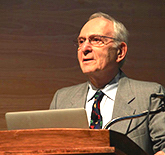The late Barbara Biber was a central figure in shaping Bank Street since its inception as the Bureau of Educational Experiments—but her impact as a researcher and scholar rippled outward, affecting change in the wider educational community. To memorialize her progressive legacy and to mark the beginning of the academic year, Bank Street Graduate School hosts the Barbara Biber Convocation each year that is led by an educator who has made a remarkable impact in his or her field. This year, new dean of the Graduate School Cecelia Traugh introduced guest speaker Herbert P. Ginsburg, a leading interpreter of children’s understanding of mathematics.
 Ginsburg, currently the Jacob H. Schiff Foundations Professor of Psychology and Education at Teachers College, Columbia University, is very much in keeping with Barbara Biber’s legacy. Barbara was a keen observer of children in the classrooms and saw the school as a “social institution that brought responsibility for the development of the whole person, his affective and social as well as his intellectual development.” Her rare insight, often documented in her elegant writings, has fueled much of Ginsburg’s work throughout his career in analyzing the developing minds of young children as they encounter mathematics.
Ginsburg, currently the Jacob H. Schiff Foundations Professor of Psychology and Education at Teachers College, Columbia University, is very much in keeping with Barbara Biber’s legacy. Barbara was a keen observer of children in the classrooms and saw the school as a “social institution that brought responsibility for the development of the whole person, his affective and social as well as his intellectual development.” Her rare insight, often documented in her elegant writings, has fueled much of Ginsburg’s work throughout his career in analyzing the developing minds of young children as they encounter mathematics.
His presentation, “Young Children’s Marvelous Mathematical Minds” comprised primarily of video footage that showed him and other experts as they tested, or “interviewed,” young children in math exercises. Many videos were amusing and also very insightful, revealing his discoveries of the fascinating ways in which children conceptualize numbers in their earliest years.
In the first video, Ginsburg worked with a child who had not yet learned to count. He put a large piece of paper in front of the student. On one side, there were 3 dots arranged in the shape of a triangle. On the other side was also a triangle of 3 dots, but the dots had more space in between them, making the triangle itself appear larger.
“Which side has more?” he asked.
The young girl thought long and hard, but eventually, she pointed to the larger triangle, even though both triangles had the same amount of dots.
“If they can’t count, they’re going to rely on the appearance of things,” Ginsburg said. “These are situations where you have to look deeper than the surface. Counting is a foolproof method for solving problems of this type.”
In another video, Ginsburg was the interviewer. He sat at a table with a young girl and put three small plastic bears in front of her. “How many bears are there?” he asked.
“Three!” she responded excitedly.
Then, maintaining her attention through a fairy tale plotline, Ginsburg told her that the three bears were going for a walk through the woods to find Goldilocks. “If these 3 bears meet 2 more bears on the way, how many bears will there be altogether?”
She took a moment, pointed to each bear on the table to count them again (“1, 2, 3…”) and then counted the imaginary bears in her head (“… 4, 5…”).
“She had a strategy that she was going to count the two sets combined,” Ginsburg said. “Kids are very abstract. They’re interested in ideas.”
In one of the last videos that Ginsburg shared, an interviewer asked “What is 8 + 7?” to a first grader. He replied, “7 + 8 = 15.” She asked how he came to that answer.
“Well, 8 + 8 is 16, and 7 + 7 is 14. If I add one more to the 7, it equals 15, and if I add one less to the 8, then it would still make 15.”
The young boy was not only able to come up with the correct answer, but he was able to describe very precisely the two methods that he used to get there.
“Knowing math must entail being able to describe what you’re doing,” Ginsburg said. “It has to involve justification. It’s a very social kind of learning. This phenomenon of a child doing something sensible and describing how he solved a problem is something we need to aim for.”
Like Barbara Biber, Ginsburg stresses the importance of uncovering what children know and identifying the skills and cognitive processes they apply at different stages in their development to reach conclusions.
“Math is not a topic entirely popular with many students, parents, teachers, and the American public at large,” Ginsburg said, “but Barbara Biber’s approach in trying to understand children’s hidden strengths applies to math as much as it does to literacy and other aspects of education.”